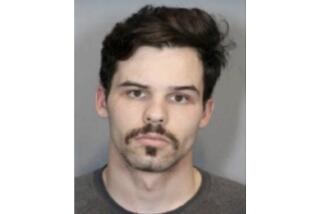S.F. sheriff explains release of 5-time deportee now charged with murder

San Francisco Sheriff Ross Mirkarimi discusses the release in April of murder suspect Juan Francisco Lopez-Sanchez at a news conference July 10.
San Francisco Sheriff Ross Mirkarimi sought Friday to explain his department’s actions in the April release from jail of a five-time deportee now charged with murder in the shooting death a 32-year-old woman as she strolled the tourist-friendly Embarcadero with her father.
The San Francisco Sheriff’s Department, like nearly all local jurisdictions and many nationwide, has stopped complying with U.S. Immigration and Customs Enforcement requests that immigrant inmates be held beyond their release dates for pickup and potential deportation.
Such a request from ICE was denied in the case of Juan Francisco Lopez-Sanchez, 52, who had been transported here on order of the San Francisco Sheriff’s Department from a Victorville federal prison where he was completing his sentence for his most recent illegal entry into the United States.
The case shines a light on a system plagued by a widespread lack of cooperation among federal immigration and local criminal justice officials, and a patchwork of relatively recent state and local laws dictating who should and should not be detained beyond their release dates to be handed over to ICE.
Those laws, among them San Francisco’s 2013 Due Process for All ordinance and California’s Trust Act, which went into effect in 2014, came in response to the federal Secure Communities program first rolled out in 2008.
That program was scrapped last fall and the latest controversy comes as ICE is rolling out the replacement Priority Enforcement Program, which in many cases will seek voluntary notification before an inmate’s release and not require any holds beyond a release date.
Mirkarimi on Friday said repeatedly that ICE detainers are “not a legal document” and that his office had notified Department of Homeland Security officials at the highest levels that they would require a judicial order or warrant to hold someone beyond their release date.
ICE does not currently issue such orders.
San Francisco’s ordinance would not have allowed for Lopez-Sanchez to be detained for ICE because his past felonies were nonviolent and he faced no current charges.
What remains unanswered is whether San Francisco will consider complying with the new Priority Enforcement Program, which in most cases will shift to requests for voluntary notification of a release -- and not request a hold -- in cases that comport to city law.
Mirkarimi said he knew little of the program’s details, although documents show that his department was among many that received a letter and other information from ICE about it last month.
Ironically, Mirkarimi confirmed that his department held Lopez-Sanchez in jail until April 15 -- 2½ weeks after prosecutors declined to pursue a 1995 marijuana possession and sales case against him.
He said the delay was caused by confusion regarding whether Lopez-Sanchez had completed his federal sentence and involved “a lot of communication” with the Bureau of Prisons in Victorville.
It also remains unclear whether Texas had ever sought Lopez-Sanchez, who was sentenced to three years of supervision after his release.
A bench warrant had been issued for Lopez-Sanchez in December 1995 after he failed to appear at his arraignment. The Sheriff’s Department was contacted about the warrant for the first time on March 23 by the federal Bureau of Prisons.
Lumping the bureau together with ICE as “the feds,” Mirkarimi questioned why they would flag the old warrant when they hadn’t done so in past instances when the bureau of prisons handed Lopez-Sanchez off to ICE for deportation.
“Federal officials could have repeated their earlier process and deported him without responding to the 1995 warrant,” he said. “This time they decided that this required a detour for this warrant.”
Sources familiar with the case said Lopez-Sanchez had never before completed a prison sentence in California. The bench warrant was a no-extradition warrant, so the Bureau of Prisons would not have flagged San Francisco to it on the two other occasions that he was handed over to ICE.
The case has triggered a political firestorm nationwide and San Francisco Mayor Ed Lee has weighed in, too, criticizing Mirkarimi for not “picking up the phone” and letting ICE know about Lopez-Sanchez’s pending release so they could pick him up.
Mirkarimi in turn lashed out at Lee on Friday for “trying to walk away or run from the ordinance he signed.”
Mirkarimi did offer some prospective solutions to “resolve the conflict of ICE compliance, local law and the 4th Amendment violations” raised by two federal courts. He suggested that an administrative law judge might be used to clarify who could be held or voluntarily turned over at the date of release.
San Francisco does not purge federal warrants from its system and Mirkarimi said that’s why his office was compelled by its own protocol to bring Lopez-Sanchez to San Francisco to appear on the bench warrant. He suggested that policy be reviewed.
Lastly, he suggested that the conflicts among local, state and federal laws might require legislative action by the mayor and San Francisco Board of Supervisors, and said the Due Process for All measure might need to be amended.
Twitter: @leeromney
More to Read
Start your day right
Sign up for Essential California for news, features and recommendations from the L.A. Times and beyond in your inbox six days a week.
You may occasionally receive promotional content from the Los Angeles Times.






